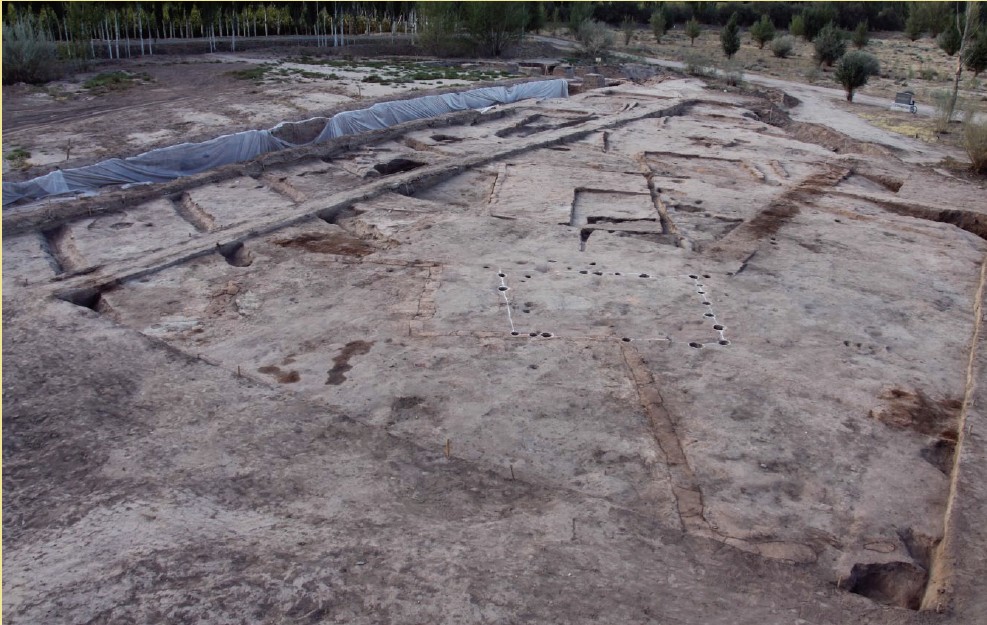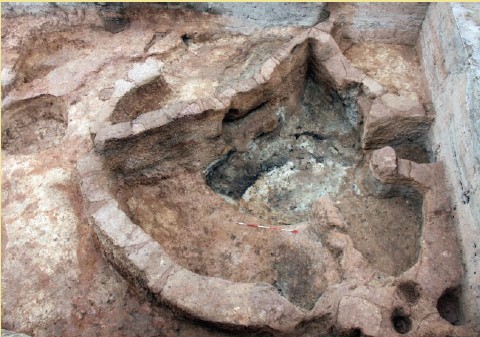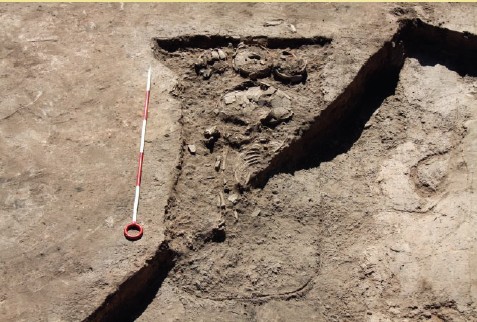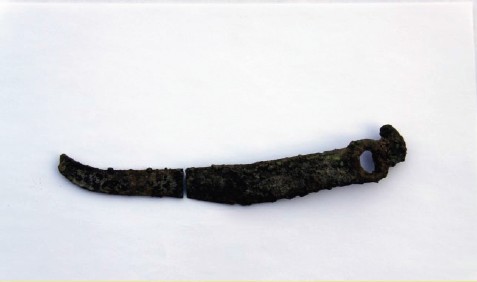Metallurgy and wheat remains discovered at Xichengyi site, Gansu
From:Chinese Archaeology NetWriter:Date:2014-02-25
The Xichengyi site is located in 3km northwest of the Xiaya village, Mingyong town, Zhangye city. It is a settlement site related to the early metallurgy dating to 4100-3600BP (from the Machang Culture to the Siba Culture in archaeology) in the middle valley of Hei River.
From 2007 to 2009, Gansu Provincial Institute of Archaeology, Metallurgy and Material History Institute, University of Science and Technology Beijing, carried out investigations three times at the site. Again, Gansu Provincial Institute of Archaeology, the Institute of Archaeology, Chinese Academy of Social Sciences, Metallurgy and Material History Institute, University of Science and Technology Beijing, and Northwest University jointly carried out excavations at the site from 2010 to 2013.

overview of the excavation areas at Xichengyi site
Currently, this site has been excavated in 1350 square meters and there were 531 remains discovered. Of these, 625 square meters was carried out in 2013 and there were 41 remains discovered so far, including 90 house foundations, 19 sections of isolated walls, 357 ash pits, 12 stove pits, 19 ash ditches and 19 tombs.
The house foundations were the most typical, including 10 semi-subterranean houses, 38 houses with pillars on the ground, 42 houses with sun-dried mud bricks walls. The semi-subterranean buildings were mostly based on a square shallow pit and had short walls building with mud-slice inside which separated a house into multi-rooms. Near the short walls were pillars supporting roof. When these houses were built, the wood structure was established first, then straw mat or straw were paved, and then mud was put at the top to form roof. The living surface inside house was a layer of red clay which was compact and very thick with 0.05-0.1 meters thickness. The houses with pillars on the ground were usually in square shape and could be divided into single- and multi-room.

semi-subterranean buildings F65
The activity surface was mostly made of compact and thick red clay, and the construction sequence included paving ground, digging pillar holes, erecting pillars, but the upper part structure was not clear yet. The houses with sun-dried mud brick walls could be divided into square and round types. The square type was mostly multi-room structure and walls were made of sun-dried mud bricks. This type of houses had large load-bearing column base and part of ground was paved with sun-dried mud bricks. The construction sequence was paving ground, digging foundation trench, filling wall base, building mud bricks, but the upper part structure was not known yet. According to the remains of F4, it might be first to build the short walls with mud bricks and then erect the posts on the walls and then build the roof.

House foundation F3 with sun-dried mud bricks walls
Burials were all distributed within the site and were mostly inside the house foundations. Single person burials were the majority and most of the burials were children’s. There was only one multiple burial having child and adult together. The burials were square earthen shaft pits and a few burials had head niche, foot niche or side niche. The grave goods in the children burials were more various than the adult’s. Additionally, a tradition was found to bury small stones (should be jade material in bluish white) in some burials.

childern' tomb M18
There were more than 2000 artifacts unearthed from the Xichengyi site, including pottery, stone artifacts, bone artifacts, bronzes, jades, jade material, crystal, seashell, lacquer skin, carbonized grains and so on. Among them, there were almost 40 small bronzes. The majority were chisels and then knives, rings and so on. In addition, a large number of slag, ores, furnace walls, blast pipes, stone moulds and other remains related to metallurgy. By excavation, a complete strata sequence was obtained from the Late Machang to the Qijia Culture to the transitional type and the Qijia Culture to the early phase of the Siba Culture. This sequence answered the issue on the origin of the Siba Culture.

pottery from tomb M13
Through the excavation on lots of house remains, it was preliminarily known that the buildings at this settlement evolved from the semi-subterranean houses to the houses with pillars on the ground type. The semi-subterranean houses mainly occurred in the late Machang Culture, and the houses with pillars on the ground type and houses with sun-dried mud bricks walls massively exist in the transitional period and Siba cultural period. These discoveries supplied reference for understanding the development of the early settlements in the Hexi Corridor area.

unearthed bronze knife
The copper metallurgy activities occurred at the Xichengyi site during the late Machang Culture and lasted to the early Siba Culture, but the transitional type period was their prosperous time. This lay the foundation for disclosing the characteristics of metallurgy in the Hexi Corridor area from the late Machang to the Siba Culture, exploring the metallurgy groups, the sources of the ores and production circulation, and supplied new materials for studying the early metallurgy technology. Moreover, the discoveries of the mirror moulds and the copper ring-pommel knife with sheep-head supplied new materials for exploring the cultural exchange and regional technology innovation.
The discoveries of lots of wheat and adobe buildings proved again that the Hexi Corridor area and the West had frequent communication over 4000 years ago. It had important significance in studying the time and route for wheat and adobe buildings to enter into China. (Translator: Zhai Shaodong)

